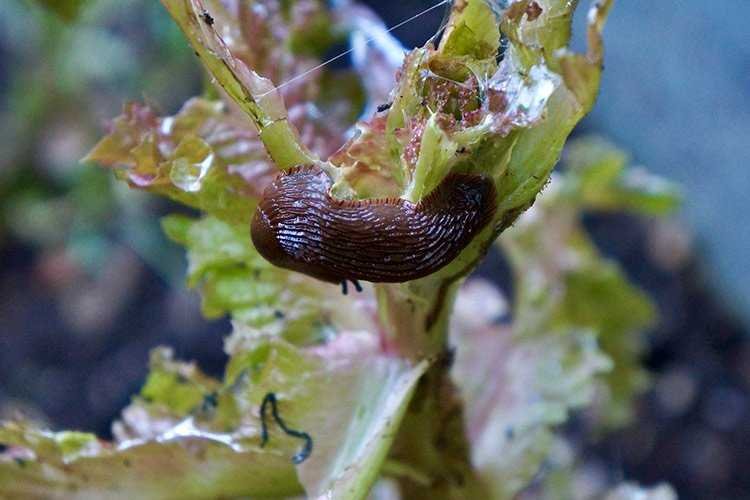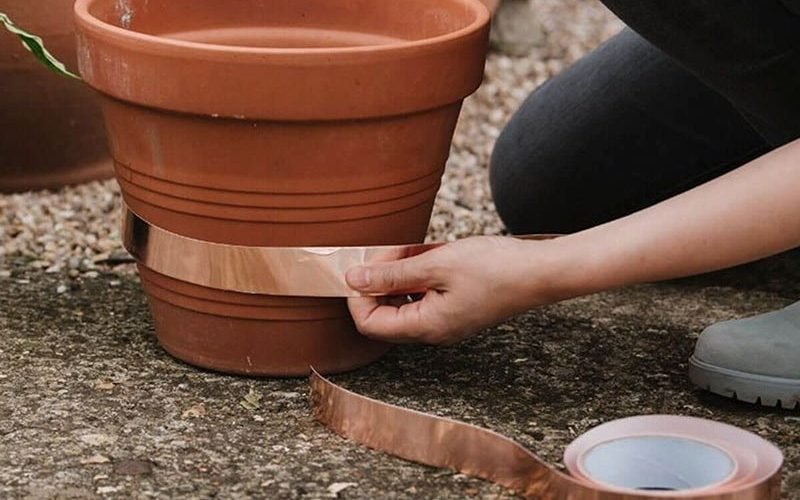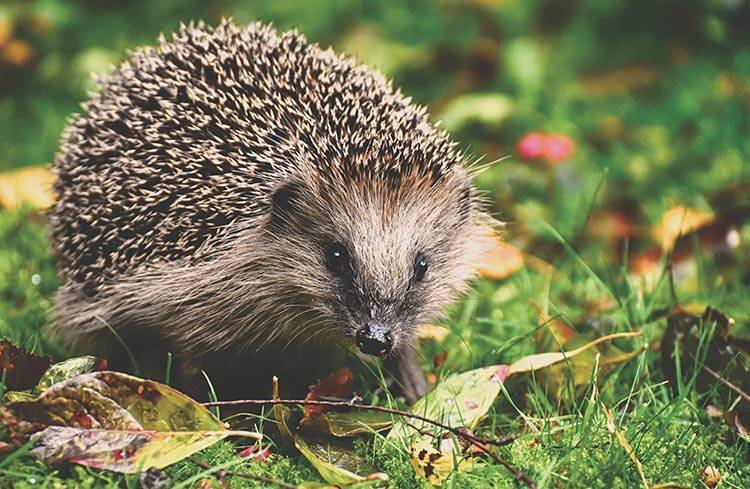Beautiful Plants For Your Interior
How To Stop Slugs Eating Plants

How to stop slugs eating plants? Are you struggling with stopping slugs from eating the plants in your garden or pots? As a gardener it can be frustrating to put time and effort into caring for your plants, only to have them destroyed by these ‘slimy’ garden pests.
Fortunately, there are several effective methods for deterring slugs from your garden plants and plant pots. You will be pleased to know these methods also work for those other munchers of plants and vegetable snails.
Prevention Methods
One of the easiest ways to stop slugs from eating plants is to use ‘scratchy’ substances, such as crushed-up eggshells, gravel, or even rough wood chippings. Simply spread them around on the surface of your soil around your plants or pots, an area of around 30-40cm should be fine, but the larger the area you can spread around the better of course, it may take a little trial and error to see what works best.
These ‘scratchy’ substances wear or remove the ‘slimy’ coating of the slugs as they crawl over it, causing them to ‘dehydrate’ and eventually die.
Coffee grounds are another good prevention method, coffee grounds have a bitter taste that slugs just don’t like so they avoid that area altogether. Just ‘sprinkle’ them around your plants and pots liberally for the best effect. However, if you have pets that roam around your garden this may not be a suitable method for you as coffee grounds aren’t good for pets.
Copper Tape/Mesh Method
Another very effective method for potted plants is to use ‘copper tape‘ or mesh around the rim of your pots. Copper is a natural repellent for slugs and snails. You can use copper tape or mesh to create a barrier around your pots. The copper will give the slimy slugs a ‘mild electric shock’ when they come into contact with it, which will deter them from climbing up and into your pots. The shock does not kill them but they will look for alternative routes in your garden but away from your potted plants.

How To Stop Slugs Eating Plants – Place Copper Tape and or Mesh Around Plant Pots to Prevent Slugs and Snails from Climbing up to Your Plants
Treatment Methods
When it comes to stopping slugs from eating plants, there are various treatment methods to consider. These methods can be divided into two main categories: Chemical Treatments and Natural Treatments.
Natural Methods
If you’re looking for a more natural solution, consider attracting predators to your garden. Birds, hedgehogs, and frogs are all-natural enemies of slugs and snails. You can even try companion planting with plants that slugs don’t like, such as lavender or rosemary.
These individual natural methods or a combination of some, can be used to naturally prevent slugs and snails from eating your plants.
Other natural methods include:
- Birds: Encourage birds to visit your garden by putting up bird feeders and bird baths. Birds are natural predators of slugs and will help keep their population under control.
- Mulch: Mulch your pots and plant areas with materials like straw, leaves, or grass clippings. Mulch will help keep the soil moist and cool, which will discourage slugs from laying their eggs in your pots and garden
- Dark: Slugs are nocturnal and prefer to feed in the dark. Keeping your pots especially, in a well-lit area will make them less attractive to slugs.
- Bran: Sprinkle ‘fine’ bran around plants in your vegetable beds and around your pots. Slugs will eat the bran, which will then expand/swell in their stomachs and kill them.
- Garlic: Spraying a garlic solution on the plants can deter slugs and snails. To make the solution, crush a few garlic cloves and mix them with water. Strain the mixture and spray it on the leaves and stems of the plants.
- Eggshells: Crushed eggshells can be scattered around your plants and in your pots. The sharp edges of the eggshells will deter slugs from crawling over them. (see above)
- Predators: Encourage other natural predators of slugs like hedgehogs, frogs, and toads to visit your garden.
- Beer Trap: Placing a shallow dish of beer near a pot or plant can attract slugs. Once they climb into the dish, they will drown in the beer. This method can be effective, but it requires regular maintenance to replace the beer.
- Nematodes: To protect your plants from slugs and snails, consider using nematodes, which are tiny micro-organisms that reside in the soil. Nematodes can help control the slug population as they are natural parasites to these slugs and snails. To apply nematodes to your soil, simply mix them with water and distribute them evenly over the affected area. It’s essential to ensure that the soil temperature is above 5°C for the treatment to be successful though.
- Garden pests: Keep your garden free of other pests like aphids and caterpillars. These pests attract slugs to your garden.
Simply try using a combination of these natural prevention methods above, and you can effectively stop or hugely reduce slugs and snails from eating your plants. Overall, though there are various treatment methods available to stop slugs from eating plants. It is important to consider the environmental impact and choose a method that is safe for the plants and the surrounding ecosystem.
Chemical Treatment
Chemical treatments involve the use of pesticides, which can be effective in killing slugs and snails. However, it is important to use them with caution as they can also harm beneficial insects and other animals. Some chemical treatments include:
- Saltwater: Spraying salt water on the leaves, stems, and flowers of plants can deter slugs. However, it can also harm the plants if used in excess.
- Animal Safe Pellets: One popular option is Sluggo, which contains iron phosphate and is safe for pets and wildlife.
- General Slug Pellets: These can be used as a last resort. They contain a toxic substance that will kill slugs, but they should be used sparingly and with caution.
Protecting Specific Plants
If you have specific plants that are being targeted by slugs, there are a few extra steps you can take to protect them. Here are some tips for protecting fruits.
Protecting Fruits
If you have strawberry plants in your garden or in pots for instance, you can protect them in ‘addition’ to the methods mentioned above by using a ‘fine’ netting to cover the plants. This will further prevent slugs from getting to the strawberries.
You can also try using a physical barrier such as a ‘plastic cup’ with the bottom cut out and pushed into the soil around the plants. This net method you can use for all soft fruits and vegetables like lettuce
Environmental Factors
When it comes to protecting your potted plants from slugs, understanding the environmental factors that attract them is crucial. Below, we will discuss the impact of light and temperature, moisture and humidity, as well as shelter and hiding spots on the presence of slugs in your garden.
Light and Temperature
Slugs are most active during the spring and after dark, so it’s important to keep an eye on your plants during these times. They also prefer damp and hot conditions, so be mindful of how much sun your potted plants in particular are getting. If they’re in direct sunlight for too long, the soil may dry out and attract slugs seeking moisture when you water them.
Moisture and Humidity
Slugs need moisture to survive, we all know keeping the soil in your garden, and particularly your pots moist is essential for healthy plant growth. However, be careful not to overwater as this can lead to waterlogged soil, which is also very attractive to slugs.
Consider using a watering can with a long spout to water your plants directly at the base, rather than spraying the leaves and soil. This watering method will help in your battle with slugs and snails
Shelter and Hiding Spots
Slugs love to hide under plant debris, so it’s important to keep the area around your garden and potted plants clean and tidy. Remove any fallen leaves or dead plant matter regularly
In terms of natural predators, blackbirds and thrushes are known to eat slugs and snails, while frogs can be great at controlling their population as we have discussed above. However, these predators may not be present in your garden, so it’s important to take other measures to protect your plants as we advise.
By understanding the environmental factors that attract slugs, you can take several steps to protect your garden and your potted plants, keeping them healthy and thriving.

How To Stop Slugs Eating Plants: Encourage Natural Predators Like ‘Hedgehogs’ Into Your Garden to Reduce the Slug Population.
FAQs
What Are The Signs of Slug Damage on Plants?
The signs of slug damage include irregular holes in leaves, slimy trails, and missing leaves. Additionally, plants may appear wilted or yellow due to the damage caused by slugs.
What Plants Are Most Susceptible to Slug Damage?
Plants with thin or delicate leaves, such as hostas, lettuce, and strawberries, are particularly vulnerable to slug damage. Additionally, plants that require moist soil or are located in shady areas are more likely to attract slugs.
Can Slugs be Beneficial in The Garden?
Although slugs are often seen as pests, they can also have beneficial effects in the garden. Slugs help to break down organic matter, which releases nutrients into the soil, and they can also serve as a food source for other wildlife, such as birds and hedgehogs. Additionally, some species of slugs are considered beneficial, such as leopard slugs, which feed on other slugs and snails.
Conclusion
In conclusion, slugs and snails can be a real nuisance for gardeners, causing significant damage to plants and flowers. However, there are a variety of methods available to stop slugs and snails from eating your plants. From physical barriers to natural repellents, there are plenty of options to choose from.
One effective method is to use copper tape or mesh around the base of plants to deter slugs, as they are repelled by the electrical charge given off by copper. Another natural solution is to use beer traps, which attract slugs and drown them.
Overall, the key to stopping slugs and snails from eating your plants is to use a combination of the methods stated above and stay vigilant in your gardening efforts. By following these tips, you can help protect your plants and keep your garden looking healthy and beautiful.
